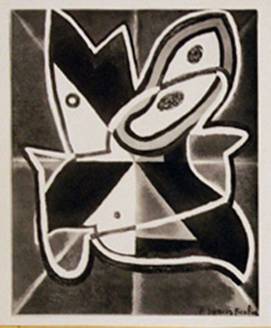


Lu-Li , 1947-1949
Oil on board, 28 1/2 x 23 1/2 inches
In January of 1945, Picabia, who had lived in the south of France for some twenty years, returned to Paris. The paintings made during the last years of his life were a remarkable synthesis of his earlier work, containing, as William Camfield observed, “aspects of Dada, the monsters, the transparencies, the superimpositions and the abstract compositions of the late 1930s.”(1) Various elements of these earlier phases in his work can be discerned in Lu-Li, a painting that was painted around 1946, but subsequently altered (probably around 1949). A black-and-white photograph of the earlier state of the picture is preserved in a photo album of Olga Mohler [Picabia] (see image below), where the basic form of the final composition is already established.(2)
 At a subsequent date—probably just a few years after the picture was painted—Picabia painted over portions of the image, and added an assortment of details. The result is that he transformed an essentially abstract composition into a figurative one: if the circle added to the beaklike projection in the lower right is read as an eye, then the whole shape of a dove suddenly appears. A dove would be an appropriate allusion, for the war had just ended, and Picabia celebrated the event not only by returning to Paris, but also by transforming this picture into the universal symbol for peace on earth.
At a subsequent date—probably just a few years after the picture was painted—Picabia painted over portions of the image, and added an assortment of details. The result is that he transformed an essentially abstract composition into a figurative one: if the circle added to the beaklike projection in the lower right is read as an eye, then the whole shape of a dove suddenly appears. A dove would be an appropriate allusion, for the war had just ended, and Picabia celebrated the event not only by returning to Paris, but also by transforming this picture into the universal symbol for peace on earth.
An alternate, alchemical reading of this image has also been suggested. The picture is clearly divided into quadrants. If the lower right section can be interpreted as a bird, then an allusion to flight is provided (thereby representing the symbol of air); read clockwise, the essential elements of matter could be seen in the remaining forms: the head of a horse or turtle on the left (earth); the spiked forms on the upper left against an opaque background (fire); and the amoeba or fishlike shape on the upper right (water).(3) Of course, it is wholly uncharacteristic of Picabia to consciously infuse any of his works with such a specific, literal meaning. Indeed, either one of these interpretations—the dove of peace, or the four elements of matter—are quickly derailed by Picabia’s title, Lu-Li (added when the compositional changes were made), a name that suggests a stripper or prostitute from Pigalle. Even in these late years of his life, it is not unlike Picabia to circumvent any logical interpretation of his pictures. The disparity of his working method was explained in a letter written in 1949: “Thinking differently from other people is less the effect of a superior intelligence than of strange anti-gregarious inclinations.”(4)
1 William A. Camfield, Francis Picabia: His Art, Life and Times (Princeton: Princeton University Press, 1979), p. 261.
2 Citation to photo album. The photograph of this picture is attached to a page containing clippings dating from 1949, although this is no indication of the date of his painting (since many of the photographs were attached wherever space allowed, and they are not necessarily in chronological sequence).
3 These were suggested in conversation by Charles H. Duncan, Collection Specialist for the New York Region, Archives at the Archives of American Art.
4 Letter from Picabia to Christine Boumeester, quoted in Maria Luisa Borràs, Picabia (New York: Rizzoli, 1985), p. 454. Borràs also notes that Picabia expresses similar sentiments in four other letters written between 1946 and 1949 (n. 56, p. 461).